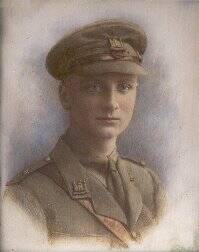Villers-Faucon Communal Cemetery Extension
Historical Information (Source: CWGC)
Villers-Faucon was captured by the 5th Cavalry Division on 27 March 1917, lost on 22 March 1918, and retaken by III Corps on 7 September 1918. The Commonwealth graves in the Communal Cemetery are those of soldiers who died in February-August 1917, or (in the case of two who are buried in Row B) in September 1918. They were made by the cavalry, the 42nd (East Lancashire) Division, and other fighting troops.
The communal cemetery contains 227 First World War burials, five of them unidentified, and 91 German graves.
The Extension was begun in April 1917 and used until March 1918. It was then used by the Germans, and Commonwealth burials were resumed in September and October 1918. Further Commonwealth graves were brought in after the Armistice from a wide area round Villers-Faucon.
The extension contains 459 Commonwealth burials and commemorations of the First World War. 144 of the burials are unidentified but there are special memorials to six casualties believed to be buried among them. The extension also contains 66 German graves, 33 being unidentified. The Commonwealth plots were designed by Sir Herbert Baker.
Cemetery
Served with
- United Kingdom (223)
- German (80)
Served in
- Army (301)
- Air Force (2)
Extension
Served with
- United Kingdom (297)
- German (33)
- Indian (10)
- Australian (7)
- New Zealand (1)
Served in
- Army (347)
- Navy (1)
VICTORIA CROSS
Second Lieutenant John Spencer DUNVILLE - 1st (Royal) Dragoons
Died 26 June 1917 Age 21
Country of Service: United Kingdom
Awards: Victoria Cross
Citation
An extract from "The London Gazette," No. 30215, dated 31st July, 1917, records the following:-"For most conspicuous bravery. When in charge of a party consisting of Scouts and Royal Engineers engaged in the demolition of the enemy's wire, this officer displayed great gallantry and disregard of all personal danger. In order to ensure the absolute success of the work entrusted to him, 2nd Lt. Dunville placed himself between the N.C.O. of the Royal Engineers and the enemy's fire, and thus protected, this N.C.O. was enabled to complete a work of great importance. 2nd Lt. Dunville, although severely wounded, continued to direct his men in the wire-cutting and general operations until the raid was successfully completed, thereby setting a magnificent example of courage, determination and devotion to duty, to all ranks under his command. This gallant officer has since succumbed to his wounds."
Grave Reference: A. 21.
(Source: Wikipedia)
Second Lieutenant Hardy Falconer PARSONS - 1st/2nd Bn. attd. 14th Bn. Gloucestershire Regiment
Died 21 August 1917 Age 20
Country of Service: United Kingdom
Awards: Victoria Cross
Citation
An extract from "The London Gazette," dated 17th Oct., 1917, records the following:-"For most conspicuous bravery during a night attack by a strong party of the enemy on a bombing post held by his command. The bombers holding the block were forced back, but Second Lieutenant Parsons remained at his post, and, single-handed, and although severely scorched and burnt by liquid fire, he continued to hold up the enemy with bombs until severely wounded. This very gallant act of self-sacrifice and devotion to duty undoubtedly delayed the enemy long enough to allow of the organisation of a bombing party, which succeeded in driving back the enemy before they could enter any portion of the trenches. The gallant officer succumbed to his wounds."
Grave Reference: A. 16.
(Source: Wikipedia)






































